The week at a glance
- Britain's first Slaty-backed Gull in London
- American Coot still in Co Mayo
- Pacific Diver still in Cornwall
- Lesser White-fronted Goose still in Norfolk
- House Crow still in Co Cork
We thought last week was a sparse one for new arrivals; this week was equally quiet. One star bird did shake us out of the doldrums, though, but didn't really play ball. Persistence paid off when BirdWatch editor Dominic Mitchell found an odd-looking gull at Rainham landfill site (London), which he saw for just three minutes on 14th. His suspicions were well founded, and news was released in the evening of what looked to be Britain's first Slaty-backed Gull, a fine-looking adult. It was then seen several times on 15th, but the 1,200 birders who swarmed over the site on Saturday 16th were mostly disappointed. There were several claims during the day, but the vast majority went home disappointed. The only dramas of the day were a fainting birder, claims and counter-claims of a possible Kumlien's Gull, and a leucistic Herring Gull that was variously strung as Glaucous and Iceland Gull.
Slaty-backed Gull, Rainham, London (Film: Waderwatcher).
The only possible confusion with this bird is the spectre of a hybrid origin, though this bird does seem to be the real deal. Further discussion on an interesting-looking hybrid in Shetland in February 2002 makes for an interesting read, as does an irreverent look at the vagrancy potential of the species by the Punkbirders. This is actually the second (or third) for the Western Palaearctic, following a midweek bird in Lithuania in November 2008 that also disappeared for the weekend. The crowd dipping that first was on a somewhat smaller scale, though, with just 12 birders present! Possibly the same bird was then seen in Latvia in April 2009 where it was slightly more amenable.
Several other megas were still around to be appreciated, some easier than others. Norfolk's Lesser White-fronted Goose was reported throughout the week at Cantley and Buckenham Marshes, the American Coot was at Termoncarragh Loch (Co Mayo) to at least 16th and the Pacific Diver was off the Cornish coast at Marazion on 17th and 18th. After a short absence, presumably of observers not bird, the House Crow was reported at Cobh (Co Cork) a couple of times during the week.
The only Snow Goose reported was the adult white morph still at Greyabbey (Co Down) on 17th, and the only Ross's Goose was the regular bird roaming around the north Norfolk coast most of the week (also seen at Waxham on 14th–15th). There was also a report of a possible with Barnacle Geese again at Burgh Marsh (Lancashire) on 19th.
Fewer reports of Black Brants were received, but they included the long-staying birds on the north Norfolk coast and the relatively new arrivals at Bembridge Harbour (Isle of Wight) and Wallasea Island (Essex). The only others were a singleton at Thorney Island and Fishbourne (West Sussex) on 16th–18th and two at Wexford Wildfowl Reserve (Co Wexford) on 13th–14th. The Red-breasted Goose continued to wander around Lancashire all week, seen at Cleveleys, Pilling Lane Ends and Eagland Hill throughout the week. There was another still at Goose Green (Jersey) to at least 17th and up to five feral birds still on the Suffolk coast. The only Richardson's Canada Goose reported was again at Raghly (Co Sligo) on 15th.

Red-breasted Goose, North Warren RSPB, Suffolk (Photo: Chris Upson)
Irish Ferruginous Ducks remained this week at Tacumshin (Co Wexford) all week, Craigavon Balancing Lakes (Co Armagh) to 17th, with a hybrid there as well, and at Lurgan Park (Co Armagh) on 18th. The only others were in East Anglia, with a female at Cockshoot Broad (Norfolk) on 16th and one at Needham Market (Suffolk) on 19th, though the latter showed some features suggesting it might be a hybrid. Good numbers of Ring-necked Ducks remained, with the long-staying bird at Cowpen Bewley (Cleveland) being particularly popular. Other drakes were at Lough Gash Turlough (Co Clare) from 13th and again at Stithians Reservoir (Cornwall) on 16th. Females were then at Nosterfield Quarry (North Yorkshire) again on 16th and at Talley Lakes (Carmarthen) on 18th.
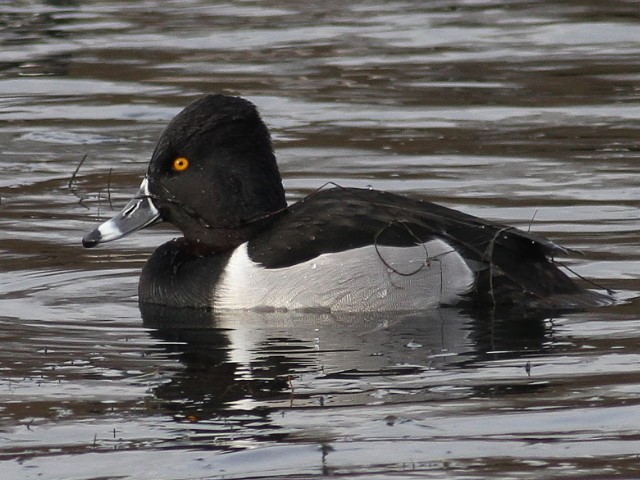
Ring-necked Duck, Cowpen Bewley, Cleveland (Photo: Ian Forrest)
Wings of various colours were present in good numbers, primarily the green variety. Green-winged Teal were reported from 11 sites, including three new birds in Lancashire. Other new birds included drakes in Orkney, Aberdeenshire, Pembrokeshire and Gloucestershire. Ireland could 'only' manage a Blue-winged Teal, with the female again at Bull Island (Co Dublin), reported on 15th–16th. The drake American Wigeons performed well at Cley Marshes (Norfolk) and Rutland Water all week, whilst the drake was again at Stoke Ferry (Norfolk) on 16th and a new drake was at Udale Bay (Highland) on 16th–17th, though has possibly been present since December. Three of the winter's Lesser Scaup remained, with the female at Slimbridge (Gloucestershire) all week and drakes still at Dozmary Pool (Cornwall) to 17th and Cosmeston Lakes (Glamorgan), the latter reappearing after a two-week absence.
The female Surf Scoter was again off Dawlish Warren (Devon) all week, and in Scotland drakes were also reported from Ruddon's Point (Fife) on 13th and 19th — with up to 65 Velvet Scoters and 6 Slavonian Grebes — and from Ferny Ness (Lothian) on 18th. The first-winter drake King Eider was again off West Voe of Sumburgh (Shetland), joined by the female previously reported there on 14th–17th. The adult drake was also still off Burghead (Moray & Nairn) to at least 17th.
Smew were reported from at least 65 sites, including five in Norfolk and four in Suffolk. There were fewer large groups, with the only double-figure count being 12 at Dungeness (Kent) on 18th. The only bird in Wales was at Shell Island (Gwynedd) on 18th, with five in Scotland and two in Ireland, at Portmore Lough (Co Antrim) and Inch Island Lake (Co Donegal).
Two Balearic Shearwaters remained in Carbis Bay (Cornwall) through the week; a concerted effort by the SeaWatch SW team at Porthgwarra (Cornwall) recorded small numbers during the week, but an impressive 29 on 16th. They also recorded up to six Manx Shearwaters and two Sooty Shearwaters, with the only other Sooty being one off The Bill at Portland (Dorset) on 17th.
Following our own speculation that the Dungeness (Kent) Glossy Ibis, which remained all week, was the same as at Freeman's Marsh (Berkshire), there was an unconfirmed report back in Berkshire on 14th, so these may in fact be different birds. Great White Egrets remained at seven sites, including five at Ham Wall (Somerset) on 17th and two at Pitsford Reservoir (Northamptonshire) on 13th–16th. New, or brief, birds were reported from Fordingbridge (Hampshire) on 17th, Sandwich Bay (Kent) on 18th and Ince Blundell (Lancashire) on 19th. Once again the only Cattle Egret was on the Channel Islands, this time at Fauvic (Jersey) again on 17th. Apart from one over Elmley Marshes (Kent) on 16th, all the Spoonbills were in the southwest, with one on Samson (Scilly), three at Walmsley Sanctuary (Cornwall) and three at Drake's Island (Devon).

Great White Egret, Pitsford Reservoir, Northamptonshire (Photo: Jonathan Smith)
Good numbers of Rough-legged Buzzards remained over the week, with birds quite widely spread in the east. The only new birds reported were a popular one at Hatfield Moors (South Yorkshire) from 13th, one at the King's Forest (Suffolk) on 16th and another at Sleddale (Cleveland) on 18th. Both of the Northern Harriers remained this week, at Tacumshin (Co Wexford) and in the Titchwell/Thornham area (Norfolk); a possible was reported at Bartinney Downs (Cornwall) on 14th–15th though possibly present there for much of the winter.

Rough-legged Buzzard, Toft, Mainland, Shetland (Photo: Brydon Thomason)

Northern Harrier, Thornham, Norfolk (Photo: Baz Scampion)
Hampshire's White-tailed Eagle stayed in the Hordle area for most of the week, though it was also reported low over Highcliffe on 18th, when it was seen by several members of public and reported on BBC Radio Solent. Also notable was a grey-phase Gyr Falcon chasing grouse at Loch Caoldair on 19th, dwarfing the Ravens mobbing it. In Cornwall the possible 'Tundra' Peregrine Falcon was again at Amble Marshes (Cornwall) to 14th, with a further late report of one (or the same) at Davidstow Airfield (Cornwall) on 16th.
Tundra Peregrine Falcon, Amble Marshes, Cornwall (Film: camelbirder).
On the wader front, the only real interest was the Long-billed Dowitcher that remained at Lodmoor (Dorset) all week.
With a bit of renewed gull interest, I bet there were a few extra pairs of bins looking at flocks over the last few days. There were still plenty of white-winged gulls around, with the best counts being three Glaucous Gulls at Loch Barvas, Lewis (Outer Hebrides) on 13th, with another three on Foula (Shetland) on 14th. Three Iceland Gulls were also at Lerwick (Shetland) on 13th, with plenty of juveniles spread around the country. Last of the big gulls was a bird at Arklow Pond (Co Wicklow) that had some features suggesting Kumlien's or Thayer's Gull, but the identification was never confirmed.
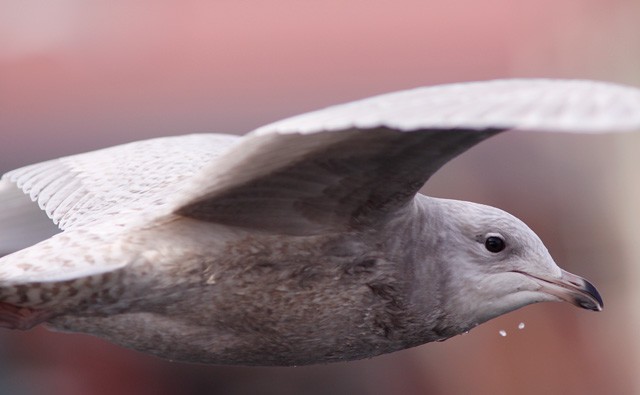
Iceland Gull, Scarborough, North Yorkshire (Photo: Terry Hobson)
All the long-staying Ring-billed Gulls were reported again this week, in Argyll, Hampshire, Essex, West Yorkshire, Co Limerick, Co Antrim, Co Cork and Co Galway. New birds were at Sandymount (Co Dublin) on 15th, Keyhaven (Somerset) on 17th and Westfield Wetlands (Co Limerick) on 17th, and one was reported from Lugg Flats, Hereford on 17th. In Ireland, an adult Bonaparte's Gull was at Great Island (Co Cork) on 15th and after not being reported for a while, the Forster's Tern was at Nimmo's Pier (Co Galway) on 13th and 19th. Also of interest was a Sandwich Tern at Stonehaven Bay (Aberdeenshire) on 17th.

Ring-billed Gull, Cuskinny Marsh, Cork (Photo: Ronan McLaughlin)
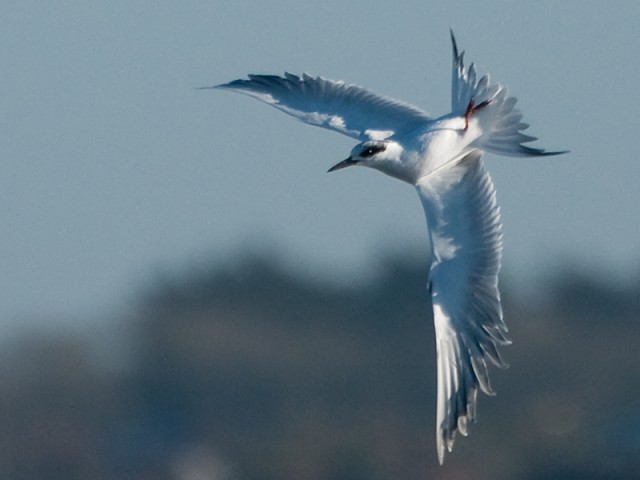
Forster's Tern, Nimmo's Pier, Galway (Photo: Tom Cuffe)
There were surprisingly few reports of Shore Lark, continuing last week's drop-off. The three main flocks remained, with 21 at Gibraltar Point (Lincolnshire), 12 at Dingle Marshes (Suffolk) and a group of up to 11 reappearing at Cley (Norfolk). Away from East Anglia, five remained at John Muir Country Park (Lothian) and three also reappeared at Reculver (Kent).

Shore Lark, Gibraltar Point NNR, Lincolnshire (Photo: Dave Goddard)
Waxwing were predictably widespread still, with most birds now concentrating in a belt through the Midlands and into London and the Home Counties. Peak counts were 225 in West Thurrock (Essex), 220 in Milton Keynes (Buckinghamshire), 200 in Bracknell (Berkshire) and 200 in Halifax (West Yorkshire). There were still only small numbers in Ireland, with birds in five counties, peaking at 50 at Clondalkin (Co Waterford) on 16th.

Waxwing, Milton Keynes, Buckinghamshire (Photo: Mike Haberfield)

Waxwing, Fair Isle, Shetland (Photo: Tommy H Hyndman)
Continuing the trend from 2010, there was a belated report of a first-winter male Black-throated Thrush on school playing fields at Woking (Surrey) on 9th January, though this potential county first hadn't been seen since. There were still several Great Grey Shrikes reported, all in England except for one at Clocaenog Forest (Conwy) on 18th (last seen on 3rd). Most were in the south as well, with the furthest north at Long Marton (Cumbria).
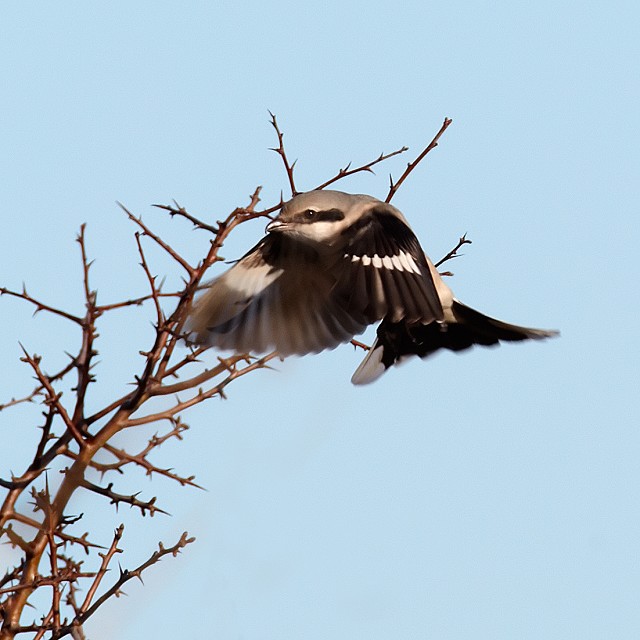
Great Grey Shrike, Sixpenny Handley, Dorset (Photo: Simon Johnson)
Long-staying Coues' Arctic Redpolls included up to three at Rainton Meadows (Durham), one (or possibly two) at Hatfield Moors (South Yorkshire) and a singleton at Whiteadder Reservoir/Cranshaws (Borders). Unconfirmed reports or possibles also came from Bellshill (Clyde) and Big Waters (Northumberland), and unidentified to race were three or four birds at Martham Ferry (Norfolk) on 19th. The influx of Lapland Buntings has either abated or there are fewer people walking stubbles, but reports this week were mostly of small numbers. The only double-figure count was of 15 at Weybourne (Norfolk) on 16th. The only really northern birds were six at Kilminning (Fife) on 13th.
As we often do, we'll finish with a round-up of the more interesting races reported during the week. Birds showing characteristics of 'Nordic' Jackdaw were at Harewood (West Yorkshire) on 18th and in an Oxford garden on 19th. It's slightly surprising that so many of these reports come from inland areas — last week's were from Staffordshire and Oxfordshire — so perhaps there's more individual variation in Jackdaws than we might appreciate. More distinctive were the two groups of Northern Long-tailed Tits in Kent. Up to five remained at Dymchurch throughout the week and two were also at Kingsdown on 16th–18th. There was also a 'possible' on Otmoor (Oxfordshire) on 17th.

Northern Long-tailed Tit, Dymchurch, Kent (Photo: Mike Gould)
The only Northern Bullfinches reported were a female at Titchwell (Norfolk) and a male in a garden at Rosyth (Fife), both on 19th. Most notable, though, was a Central Asian Lesser Whitethroat at Drogheda (Co Louth). It was first seen just after Christmas and confirmed on 14th. It was then caught and ringed, and biometrics and DNA may be able to resolve its subspecific identity.
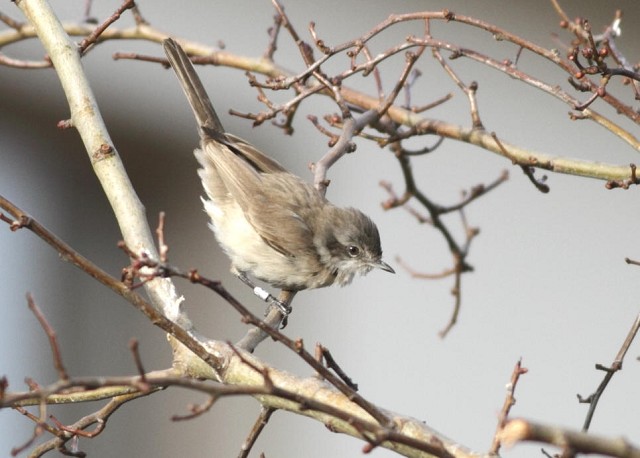
Central Asian Lesser Whitethroat, Drogheda, Louth (Photo: Gerry O Neill)
Photo of the Week: 13th–19th January 2011

Common Buzzard, Crail, Fife (Photo: John Anderson)
Fife-based bird photographer John Anderson has posted his images to BirdGuides regularly for over five years now and these regularly feature in our Weekly Reviews. John's own website — under the name of The Crail Birder — has over 5000 images beautifully documenting his local birdlife and his forays further afield, including his recent trip to the Galapagos Islands (we're not envious, really!). Over the last couple of weeks, John has been photographing a Black Redstart that's been frequenting his local cliffs. We can only imagine his surprise when, during one of these sessions, a Common Buzzard arrived on the scene and stooped at the Black Redstart as he was photographing it! As we can see, John did an excellent job of maintaining his composure to capture the dive, freezing the sunlit bird against a rich blue sky. We've seen thousands of images of raptors but to see one in this extreme posture, facing the camera with such an intense expression, is outstanding indeed.
Other notable photos

Lilac-breasted Roller, Tanzania (Photo: Gavin Farnell)

Fieldfare, Solihull, West Midlands (Photo: Mike Lane)

Short-eared Owl, undisclosed site, Derbyshire (Photo: Richard Pittam)

Barn Owl, Gayton, Norfolk (Photo: Stephen Durrant)

Sparrowhawk, Upton Warren NR, Worcestershire (Photo: Chris Cook)

Sanderling, Titchwell RSPB, Norfolk (Photo: Jon Evans)

Meadow Pipit, Kinmel Bay, Conwy (Photo: David Cookson)

Dartford Warbler, Westward Ho!, Devon (Photo: Rob Cross)

Blackcap, Alphington, Devon (Photo: Charlie Fleming)

Blue Tit, Honingham, Norfolk (Photo: Mark Skipper)

Goldcrest, undisclosed site, Warwickshire (Photo: Tom Melton)

Chaffinch, East Linton, Lothian (Photo: James Wood)
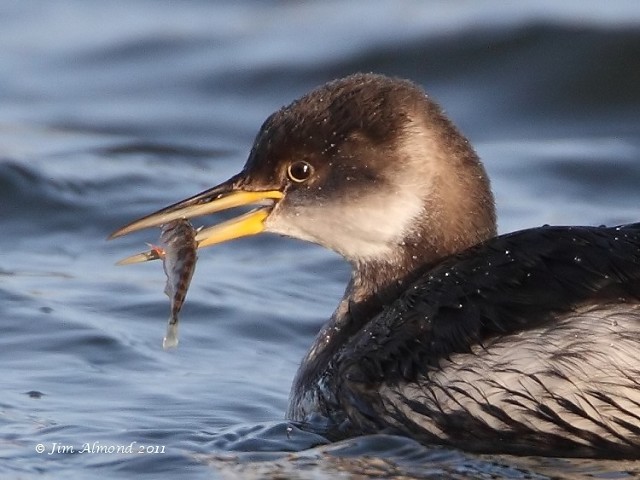
Red-necked Grebe, Fairhaven Lake, Lancashire (Photo: Jim Almond)

Curlew, Whitley Bay, Northumberland (Photo: Ron Hindhaugh)

Bittern, Netherlands (Photo: Rudi Debruyne)

Tufted Duck, Fairburn Ings RSPB, West Yorkshire (Photo: Rob Sewell)
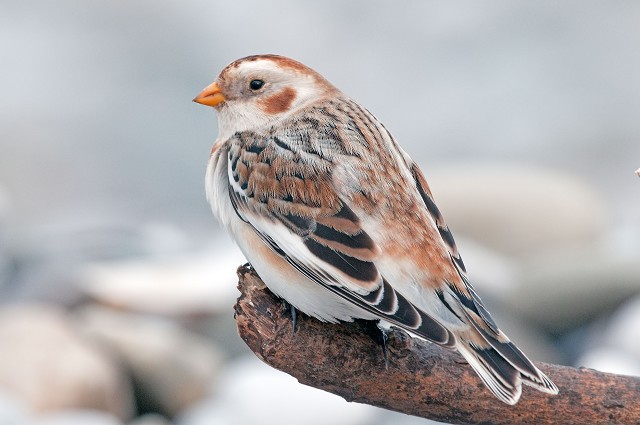
Snow Bunting, Kinmel Bay, Conwy (Photo: Jon Taverner)

Common Treecreeper, Llandrindod Wells, Powys (Photo: Kev Joynes)

Ring-billed Gull, Cuskinny Marsh, Cork (Photo: Ronan McLaughlin)

Redwing, undisclosed site, Clwyd (Photo: Richard Steel)

